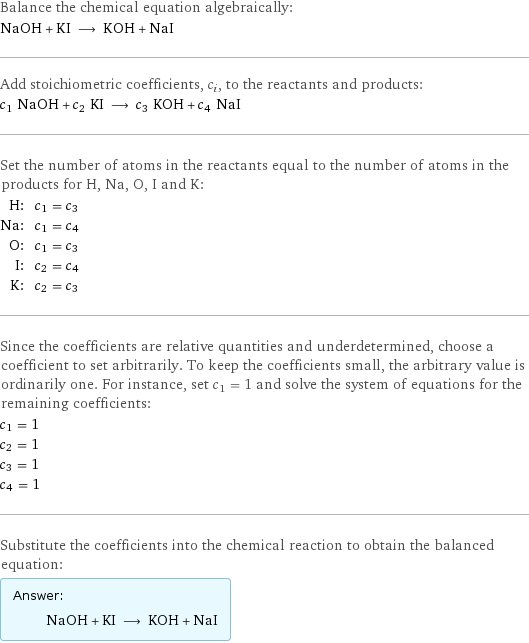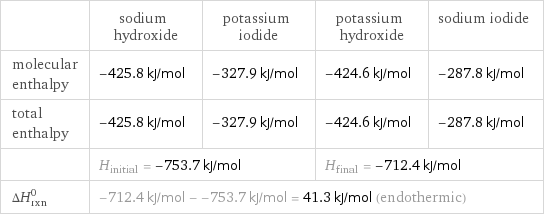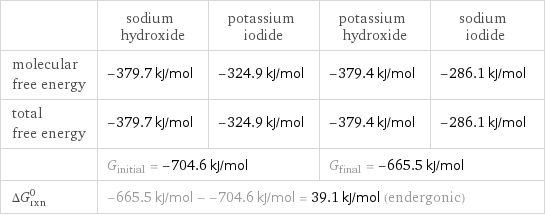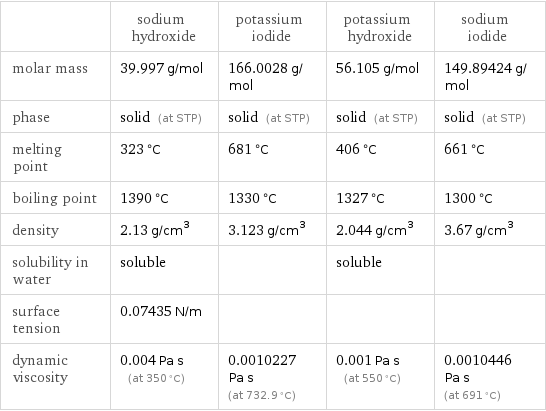Input interpretation

NaOH sodium hydroxide + KI potassium iodide ⟶ KOH potassium hydroxide + NaI sodium iodide
Balanced equation

Balance the chemical equation algebraically: NaOH + KI ⟶ KOH + NaI Add stoichiometric coefficients, c_i, to the reactants and products: c_1 NaOH + c_2 KI ⟶ c_3 KOH + c_4 NaI Set the number of atoms in the reactants equal to the number of atoms in the products for H, Na, O, I and K: H: | c_1 = c_3 Na: | c_1 = c_4 O: | c_1 = c_3 I: | c_2 = c_4 K: | c_2 = c_3 Since the coefficients are relative quantities and underdetermined, choose a coefficient to set arbitrarily. To keep the coefficients small, the arbitrary value is ordinarily one. For instance, set c_1 = 1 and solve the system of equations for the remaining coefficients: c_1 = 1 c_2 = 1 c_3 = 1 c_4 = 1 Substitute the coefficients into the chemical reaction to obtain the balanced equation: Answer: | | NaOH + KI ⟶ KOH + NaI
Structures

+ ⟶ +
Names

sodium hydroxide + potassium iodide ⟶ potassium hydroxide + sodium iodide
Reaction thermodynamics
Enthalpy

| sodium hydroxide | potassium iodide | potassium hydroxide | sodium iodide molecular enthalpy | -425.8 kJ/mol | -327.9 kJ/mol | -424.6 kJ/mol | -287.8 kJ/mol total enthalpy | -425.8 kJ/mol | -327.9 kJ/mol | -424.6 kJ/mol | -287.8 kJ/mol | H_initial = -753.7 kJ/mol | | H_final = -712.4 kJ/mol | ΔH_rxn^0 | -712.4 kJ/mol - -753.7 kJ/mol = 41.3 kJ/mol (endothermic) | | |
Gibbs free energy

| sodium hydroxide | potassium iodide | potassium hydroxide | sodium iodide molecular free energy | -379.7 kJ/mol | -324.9 kJ/mol | -379.4 kJ/mol | -286.1 kJ/mol total free energy | -379.7 kJ/mol | -324.9 kJ/mol | -379.4 kJ/mol | -286.1 kJ/mol | G_initial = -704.6 kJ/mol | | G_final = -665.5 kJ/mol | ΔG_rxn^0 | -665.5 kJ/mol - -704.6 kJ/mol = 39.1 kJ/mol (endergonic) | | |
Equilibrium constant
![Construct the equilibrium constant, K, expression for: NaOH + KI ⟶ KOH + NaI Plan: • Balance the chemical equation. • Determine the stoichiometric numbers. • Assemble the activity expression for each chemical species. • Use the activity expressions to build the equilibrium constant expression. Write the balanced chemical equation: NaOH + KI ⟶ KOH + NaI Assign stoichiometric numbers, ν_i, using the stoichiometric coefficients, c_i, from the balanced chemical equation in the following manner: ν_i = -c_i for reactants and ν_i = c_i for products: chemical species | c_i | ν_i NaOH | 1 | -1 KI | 1 | -1 KOH | 1 | 1 NaI | 1 | 1 Assemble the activity expressions accounting for the state of matter and ν_i: chemical species | c_i | ν_i | activity expression NaOH | 1 | -1 | ([NaOH])^(-1) KI | 1 | -1 | ([KI])^(-1) KOH | 1 | 1 | [KOH] NaI | 1 | 1 | [NaI] The equilibrium constant symbol in the concentration basis is: K_c Mulitply the activity expressions to arrive at the K_c expression: Answer: | | K_c = ([NaOH])^(-1) ([KI])^(-1) [KOH] [NaI] = ([KOH] [NaI])/([NaOH] [KI])](../image_source/07d1c1e5b8d28f3dfcfc1bab37e47dca.png)
Construct the equilibrium constant, K, expression for: NaOH + KI ⟶ KOH + NaI Plan: • Balance the chemical equation. • Determine the stoichiometric numbers. • Assemble the activity expression for each chemical species. • Use the activity expressions to build the equilibrium constant expression. Write the balanced chemical equation: NaOH + KI ⟶ KOH + NaI Assign stoichiometric numbers, ν_i, using the stoichiometric coefficients, c_i, from the balanced chemical equation in the following manner: ν_i = -c_i for reactants and ν_i = c_i for products: chemical species | c_i | ν_i NaOH | 1 | -1 KI | 1 | -1 KOH | 1 | 1 NaI | 1 | 1 Assemble the activity expressions accounting for the state of matter and ν_i: chemical species | c_i | ν_i | activity expression NaOH | 1 | -1 | ([NaOH])^(-1) KI | 1 | -1 | ([KI])^(-1) KOH | 1 | 1 | [KOH] NaI | 1 | 1 | [NaI] The equilibrium constant symbol in the concentration basis is: K_c Mulitply the activity expressions to arrive at the K_c expression: Answer: | | K_c = ([NaOH])^(-1) ([KI])^(-1) [KOH] [NaI] = ([KOH] [NaI])/([NaOH] [KI])
Rate of reaction
![Construct the rate of reaction expression for: NaOH + KI ⟶ KOH + NaI Plan: • Balance the chemical equation. • Determine the stoichiometric numbers. • Assemble the rate term for each chemical species. • Write the rate of reaction expression. Write the balanced chemical equation: NaOH + KI ⟶ KOH + NaI Assign stoichiometric numbers, ν_i, using the stoichiometric coefficients, c_i, from the balanced chemical equation in the following manner: ν_i = -c_i for reactants and ν_i = c_i for products: chemical species | c_i | ν_i NaOH | 1 | -1 KI | 1 | -1 KOH | 1 | 1 NaI | 1 | 1 The rate term for each chemical species, B_i, is 1/ν_i(Δ[B_i])/(Δt) where [B_i] is the amount concentration and t is time: chemical species | c_i | ν_i | rate term NaOH | 1 | -1 | -(Δ[NaOH])/(Δt) KI | 1 | -1 | -(Δ[KI])/(Δt) KOH | 1 | 1 | (Δ[KOH])/(Δt) NaI | 1 | 1 | (Δ[NaI])/(Δt) (for infinitesimal rate of change, replace Δ with d) Set the rate terms equal to each other to arrive at the rate expression: Answer: | | rate = -(Δ[NaOH])/(Δt) = -(Δ[KI])/(Δt) = (Δ[KOH])/(Δt) = (Δ[NaI])/(Δt) (assuming constant volume and no accumulation of intermediates or side products)](../image_source/e3bfa3ae6bbd34a2bb8049e770dc2cf6.png)
Construct the rate of reaction expression for: NaOH + KI ⟶ KOH + NaI Plan: • Balance the chemical equation. • Determine the stoichiometric numbers. • Assemble the rate term for each chemical species. • Write the rate of reaction expression. Write the balanced chemical equation: NaOH + KI ⟶ KOH + NaI Assign stoichiometric numbers, ν_i, using the stoichiometric coefficients, c_i, from the balanced chemical equation in the following manner: ν_i = -c_i for reactants and ν_i = c_i for products: chemical species | c_i | ν_i NaOH | 1 | -1 KI | 1 | -1 KOH | 1 | 1 NaI | 1 | 1 The rate term for each chemical species, B_i, is 1/ν_i(Δ[B_i])/(Δt) where [B_i] is the amount concentration and t is time: chemical species | c_i | ν_i | rate term NaOH | 1 | -1 | -(Δ[NaOH])/(Δt) KI | 1 | -1 | -(Δ[KI])/(Δt) KOH | 1 | 1 | (Δ[KOH])/(Δt) NaI | 1 | 1 | (Δ[NaI])/(Δt) (for infinitesimal rate of change, replace Δ with d) Set the rate terms equal to each other to arrive at the rate expression: Answer: | | rate = -(Δ[NaOH])/(Δt) = -(Δ[KI])/(Δt) = (Δ[KOH])/(Δt) = (Δ[NaI])/(Δt) (assuming constant volume and no accumulation of intermediates or side products)
Chemical names and formulas

| sodium hydroxide | potassium iodide | potassium hydroxide | sodium iodide formula | NaOH | KI | KOH | NaI Hill formula | HNaO | IK | HKO | INa name | sodium hydroxide | potassium iodide | potassium hydroxide | sodium iodide
Substance properties

| sodium hydroxide | potassium iodide | potassium hydroxide | sodium iodide molar mass | 39.997 g/mol | 166.0028 g/mol | 56.105 g/mol | 149.89424 g/mol phase | solid (at STP) | solid (at STP) | solid (at STP) | solid (at STP) melting point | 323 °C | 681 °C | 406 °C | 661 °C boiling point | 1390 °C | 1330 °C | 1327 °C | 1300 °C density | 2.13 g/cm^3 | 3.123 g/cm^3 | 2.044 g/cm^3 | 3.67 g/cm^3 solubility in water | soluble | | soluble | surface tension | 0.07435 N/m | | | dynamic viscosity | 0.004 Pa s (at 350 °C) | 0.0010227 Pa s (at 732.9 °C) | 0.001 Pa s (at 550 °C) | 0.0010446 Pa s (at 691 °C)
Units
